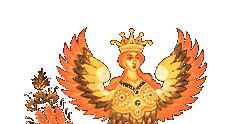"As the bells began to announce the Zautrenya (early mass) hence I saw from my light room (svetlitsa), as the good people happily hurry to church, so girlfriends, it became unbearable... Since then my heart is heavy still... and the day was so bright, so filled with sunshine, and these garments that you put onto me... Take off these bracelets, girlfriends, take off the kokoshnik, make my hair into a braid, like you have maiden-like!"
"Are you out of your mind, Boyarinya, such a sin! You want the braid made maiden-like! God have Mercy! What if Drujina Andreich finds out about this!"
"He will not find out, girlfriends! I will put the kokoshnik back on!"
--(A.K. Tolstoy "Prince Silver" chapter 5, 1862)
A kokoshnik (pronounced kah-KOSH-nick) is the headdress worn by a married woman in the central and northern regions of Russia. The headdress was worn in other regions as well, but it did not have any status symbolism to it. It is shaped as a high shield, of various designs above the forehead.
The name kokoshnik come from the Ancient Russian "kokosh" for a broon-hen, as opposed to a "kokot" for hencock, and is based on the form of the bird's crest. The shape of the kokoshnik varies from region to region.
Ethnographers have written the following: "The shapes of kokoshniks from the Northern Regions vary greatly even from regions quite close to each other. In the Ostashkovo region the surface of the helmet-like head covering was filled with "pozument" and thick gold thread embroidery, and the area next to the forehead ended in a grid of pearls or beads. Whereas as a headdress from the nearby Rjevskiy region "ryaska" was miniature in comparison; its richly
decorative band covered just a bundle of hair on the back of the head, and a thick grid "pozatilen" covered the rest of the head. A kokoshnik from the Kargopolkiy Uyezd of the Olonetsk region resembles a hat with a band
stretched outward with fans covering the ears. The surface of this kokoshnik is decorated with "pozument" and the forehead part is decorated with geometrical designs, laid out with pearls and beads. A short multilayer decorative grid is lowered over the forehead. A "kika" from the Pskovian region had unusual decorations in the form of cones, embroidered over white with pearls and beads, which resembled fertility, according to ancient belief.
In Vladimirskaya, Nizhegorodskaya, Yaroslavskaya, Kostromskaya and several other regions in the 18th century flat massive kokoshniks with a vertical or horizontal fan above the forehead are typical. These can be of a stretched upright triangle or rounded shape. In some cases they can be as long as 60 cm (24 in).
Kokoshniks were made by highly skilled craftsmen, who knew how to embroider with pearls, gold thread and were trained in the handling of factory made materials. In the artistic order of the Russian national costume, a kokoshnik was the crowning monumental shape of formal women's attire. It accented the face, underlining the importance of the festive situations when such a richly decorated headdress was appropriate. For a short time after being married, women would attach a transparent white veil, decorated with lace or pozument. This veil is called several different names: the dymka (smoke layer) or the fata or vyual (both meaning veil). In time, a very high kokoshnik with a veil began to be worn by young unwed women. In 1900, M.A. Vrubel painted the very famous painting "Princess Swan" (Tretyakov Gallery), where the kokoshnik was a key detail, organically woven into the composition, represented as a national symbol of traditional Russian costume, with a metaphoric fairytale-like poetry to it. In present time the kokoshnik resembles the beauty of a young maiden and has lost the connection to married status. Nowadays it is mostly used in theatrical scenes.
Translated from the Russian by Paul Tyutin. Text found on page 134 of  Kirsanova R.M., 1995,
"DRESS FASHION IN RUSSIAN ART CULTURE", LARGE RUSSIAN ENCYCLOPEDIA, Moscow, 5-85270-144-0 Kirsanova R.M., 1995,
"DRESS FASHION IN RUSSIAN ART CULTURE", LARGE RUSSIAN ENCYCLOPEDIA, Moscow, 5-85270-144-0
|



